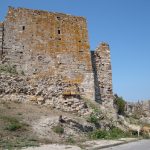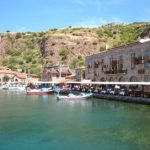The Northern Aegean is the stretch of coastline running between the pleasant small town of Çanakkale in the north and big, bustling İzmir, Turkey’s third largest city, in the south.
For most foreign visitors its most obvious drawcards are the First World War battlefields of Gallipoli with their haunting reminders of British blunders and Turkish determination, and the site of Troy, the city made famous by Homer’s epic, the Iliad. Keen archaeologists also head here to visit Bergama, the ancient Pergamum, where impressive ruins are scattered about an otherwise undistinguished little town.
Surprisingly few foreigners find time for the area’s other main assets which include the beautiful hill and port town of Assos/Behramkale, delightful Ayvalık with its off-shore extension on Cunda, and Turkey’s only two inhabited Aegean islands, Gökçeada and Bozcaada. There are lots of sandy beaches along this coast, most of them, such as Sarımsaklı near Ayvalık, heavily developed but others, such as those on Bozcaada, still romantically isolated.
Sadly, the coast road around the Gulf of Edremit from Altınoluk to Burhaniye is solidly built up with holiday villages and summer-home developments. Drive quickly past trying not to look to left or right.
Getting there
For people with their hearts set on Gallipoli, there’s little alternative to the six-hour bus ride from İstanbul which follows the coast road north along the Sea of Marmara, then tracks the Dardanelles before crossing to Çanakkale at Eceabat. For those more interested in Bergama it makes sense to fly to İzmir and then take a north-bound bus. The journey between Çanakkale and İzmir tends to be slow but the buses are big and comfortable, and there are plenty of places to stop along the way.
The battlefields of Gallipoli, just north of Eceabat, are one of the main attractions of Turkey for all sorts of reasons. It was here in 1915 that the British persuaded the ANZAC troops from Australia and New Zealand to land and attempt to hold the Dardanelles to prevent their enemies gaining sea access to İstanbul. The plans went awry almost from the get-go, and it probably didn’t help that the ANZACs found themselves confronting troops led by Mustafa Kemal, the man who was to become Atatürk, the first president of the Turkish Republic. Thousands lost their lives here and were buried in cemeteries strewn across the hillside.
It has become a rite of passage for young Aussies and Kiwis to come here on ANZAC Day (25 April) to attend dawn services on the beaches, but the sites are also enormously important to Turks who hold their own ceremonies on 18 March. Even if military history is not your thing, it’s still worth coming here for the beauty of the peninsula. Local guides are also renowned for their ability to conjure up what happened in a way calculated to melt the hardest of hearts. A word of warning. If ANZAC Day is not especially important to you be sure to visit at another time – on 25 April every hotel for miles around will be booked up, and the queues and general disruption are considerable.
Is it worth visiting Troy? Well, it probably depends on how interested you are in history and how vivid an imagination you have because the ruins here are by no means as dramatic as those, for example, at Bergama. They are also the remains of nine cities piled one on top of each other which can make for confusing viewing despite the excellent signage. Still, the views of the surrounding Troad are magnificent, and children will love climbing into the model Trojan horse parked conveniently near the entrance. The new Troy Museum is also a state-of-the-art affair.
Backpackers often stay across the Dardanelles in Eceabat but Çanakkale, with its large student population, is a bigger and livelier town with much more to offer visitors including an array of inviting bars, restaurants and water-facing tea gardens. Except for the week around ANZAC Day it also has a glut of accommodation options, most of it fairly prosaic with the appealing exception of the Hotel Kervansaray, housed in an old pasha’s house. It’s easy to arrange tours to the Gallipoli battlefields and to Troy here – – or you can arrange to emulate Leander’s feat in swimming across the Hellespont (Dardanelles) to visit his sweetheart, Hero, on the other side.
The lovely little harbour of Assos with its half-dozen warehouses-turned-hotels has always been one of Turkey’s greatest gems. These days, however, the secret is out and in summer you won’t be able to find a bed in the hotels, nor yet be able to move on the promenade, for holidaying Turks and their families. The harbour hotels have tended to rest on their water-facing laurels but on the hillside above you’ll find a string of boutique hotels including the Biber Evi whose owner is renowned for his skills as a chef. Right at the top of the hill the romantic ruins of a temple to Athena gaze out over the Greek island of Lesbos. Assos is always crowded at weekends and attracts lots of school parties in late spring. Come mid-week to be assured of a good time.
At first sight Ayvalık doesn’t look too promising and you might be tempted to whisk straight through. Get out of the bus and strike out into the back streets, however, to find street after street of lovely old Ottoman Greek houses, some of them turned into bijou hotels. Specific sights are few although there’s a lively street market and several fine 19th-century churches. Soaring chimneys are reminders of a once-thriving olive-oil production industry that is now getting back into its stride. Town buses ply the causeway to Cunda, a delightful island with a string of fish restaurants and yet more lovely old Greek houses. For those in search of peace and quiet, this could be the perfect place to put down roots.
With its hilltop shrine to the Greek god of healing, Asclepius, its magnificent Acropolis with the most vertigo-inducing ancient theatre in Turkey, and its excellent museum, Bergama deserves to attract many more visitors than it does. Unfortunately the sites are widely spread out (a funicular has considerably improved access) and the town is surprisingly low on good places to stay and eat. Solve that problem perhaps by visiting on a day trip from Ayvalık.
Lovely old houses, a string of fish restaurants, beautiful sandy beaches – Bozcaada has it all. Getting here is a little time consuming which means that few foreign visitors make it. Those that do, however, find a delightful island whose main town boasts a virtually unspoilt Ottoman Greek townscape, with several of the houses turned into delectable small hotels. Beyond the town lie lovely sandy beaches fringed with dunes. Get to them by bus or bicycle.
Gökçeada is easier to get to since there are regular ferries from Çanakkale. Once here, however, you really need a car to get around what is a very hilly island whose settlements are widely dispersed on the hilltops. Most inviting are Tepeköy, Zeytinli, Dereköy and Yukarı Kaleköy. Accommodation on the island is limited – you’d be well advised to book ahead.
Trekkers and lovers of wild rural scenery will adore the pretty stone-built villages in the foothills of Kaz Dağı (the ancient Mt Ida). Needless to say, it’s not an easy area to explore without your own car.
Finally, the small resort towns of Eski and Yeni Foça make pleasant places to stay and mingle with Turkish holidaymakers. Eski Foça has a pair of colourful harbours, Yeni Foça an array of abandoned Ottoman Greek houses fast acquiring new life as holiday homes for İzmir residents. Over summer weekends all the accommodation gets booked up by visiting İzmirlis.

